Whether it’s for your phone, GPS tracker, camera, or headlamps, you are probably going to need some power during your backpacking trip. A backpacking power bank is simplest way to make sure your devices don’t die on you.
Luckily, power banks have gotten a lot lighter over the years and can get more than 1,600mAh of power per ounce. Some backpacking power banks are even durable and waterproof too.
Here’s the best power banks for backpacking. If you don’t know how much power you will need or what to look for then scroll down to read the complete guide.
Quick Picks:
- Best Overall: NiteCore NB10000 (10,000mAh, 5.3oz)
- Runner Up: Goal Zero Flip 24 (6,700mAh, 4.6oz) -also available at REI
Comparison Table
| Product | mAh | Weight (oz) | mAh per Oz | Out Ports | Output | Input |
|---|---|---|---|---|---|---|
| Anker PowerCore Compact | 5,000 | 4.8 | 1,040 | 1 | USB-A 2A | Micro-USB 2A |
| Anker PowerCore 10000 | 10,000 | 6.35 | 1,575 | 1 | USB-A 2.4A | Micro-USB 2A |
| Anker PowerCore 10000 Slim PD | 10,000 | 7.52 | 1,330 | 2 | USB-A 2.4A, USB-C 3A (3.6A max) | USB-C 20W |
| Anker PowerCore 20100 | 20,100 | 12.6 | 1,595 | 2 | USB-A 4.8 (2.4 each) | USB-A 2A |
| NiteCore NB10000 Ultra Slim | 10,000 | 5.3 | 1,887 | 2 | USB-A 5V 3A, USB-C 18W | USB-C 18W |
| Goal Zero Flip 24 | 6,700 | 4.6 | 1,457 | 1 | USB-A 2.1A | USB-A 2.1A |
| Goal Zero Flip 36 | 10,050 | 6.8 | 1,478 | 1 | USB-A 2.1A | USB-A 2.1A |
| Goal Zero Venture 35 | 9,600 | 10.1 | 950 | 2 | UBS-A 3A, USB-C PD 5-12V 3A | USB-C PD 18W |
| BioLite 20 PD | 6,000 | 5.8 | 1,034 | 3 | USB-A 3A, USB-C 18W | USB-C 18W |
| BioLite 40 PD | 10,000 | 9.4 | 1,063 | 3 | USB-A 3A, USB-C 18W | USB-C 18W |
| BioLite 80 PD | 20,000 | 16.4 | 1,220 | 3 | USB-A 3A, USB-C 18W | USB-C 18W |
| Charmast Display Power Bank | 10,400 | 8 | 1,300 | 3 | USB-A 5V 3A, USB-C 5V 3A | Micro USB, USB-C 3A |
Best Power Banks for Backpacking
1. Anker Power Banks
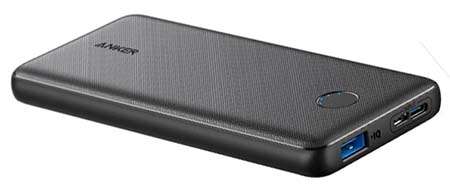
Choose If: You want a reputable brand with fantastic capacity-to-weight ratio
Anker is one of the best known brands for backpacking power banks (as well as other gear like portable solar panels). They have power banks in different capacities. All of them have a good weight-to-capacity ratio (or milliamps per ounce).
Another reason to choose Anker power banks is that they actually deliver close to their advertised efficiency. Whereas other power banks might only give 2/3 of their listed power, Anker gets up to 90% efficiency.
You can also expect advanced features like 2.4amp fast charging, durable design, and a good 18 month warranty. They are actually affordable too, so definitely worth buying instead of a knockoff brand.
Recommended Anker Power Banks for Backpacking:
Anker has dozens of different power banks. It’s actually confusing as heck trying to figure out the difference between them. For backpacking, these are their best options.
- PowerCore Compact 5000 (5,000mAh, 4.8oz): The mAh per ounce on this power bank is actually pretty low (just 1,040mAh per oz.). However, a lot of people like this one because of the 2A charging (in and out). Get it if you need to recharge fast.
- PowerCore 10000 (10,000mAh, 6.35oz): This has a very high mAh per ounce of 1,575. That makes it one of the lightest backpacking power banks available. Note it is NOT compatible with devices with an input below 50mA, such as some GPS devices.
- PowerCore 10000 PD (10,000mAh, 7.52oz): It is slightly heavier than the previous version, but has two outputs so you can charge two devices at once.
- PowerCore 20100 (20,100mAh, 12.6oz): Choose this power bank if you need to charge multiple devices at once quickly. It’s got 2 outlet ports at 2.4A each. It’s also got a great mAh per ounce ratio.
2. NiteCore NB10000 Ultra-Slim (10,000mAh, 5.3oz)
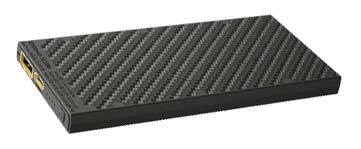
Choose If: You are willing to pay a bit more for very lightweight power bank
Here’s a more standard type power bank from NiteCore. It’s the one I take with me on most backpacking trips and I’m really happy with it. As you’d expect from this brand, the power bank is insanely lightweight. It is 10,000mAh capacity but weights just 5.3oz, which breaks down to 1,887 mAh per ounce.
That’s lighter than any other power bank that I’ve found. The only drawback? It is the priciest option of all the backpacking power banks reviewed here.
Get it at Amazon
3. Goal Zero Flip Power Banks
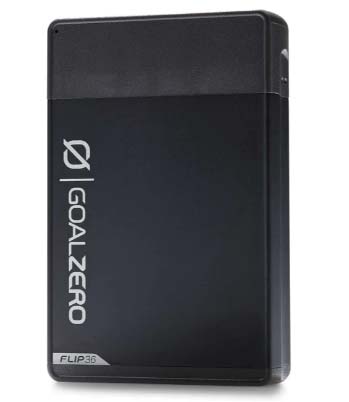
Choose If: You need a faster charging time and like the Goal Zero brand
Goal Zero is better known for their solar panels but they also make these portable power banks too. Their flip series are lightweight and have a good mAh to weight ratio. The weight isn’t as good as Anker but the power banks do charge faster. Currently, they have 6,700mAh and a 10,000mAh power banks available.
Get Them Here on Amazon. Also available at REI.
4. Goal Zero Venture 35
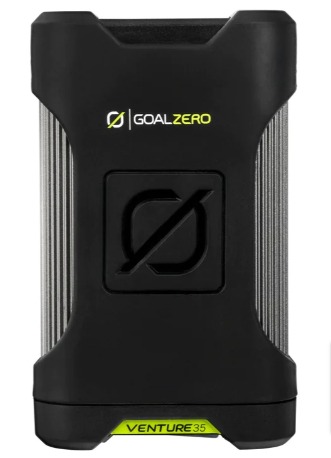
Choose If: Waterproof ness and durability matter to you more than weight
The Goal Zero Venture 35 power bank is 9,600mAh at 10.1oz. That is actually really heavy per mAh. But the power bank has some features which might make this worth it: An IP67 rating (it’s actually waterproof), a much more durable construction, fast charging with USB-C and multiple out ports. The charger also doubles as an emergency flashlight.
Get It Here on Amazon. Also available at REI.
5. BioLite PD Power Banks
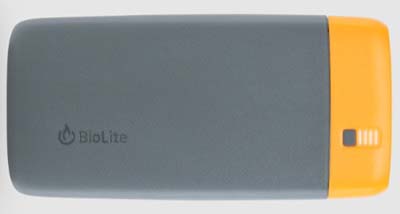
Choose If: You want to charge multiple devices quickly
While not as light as Anker, BioLite PD power banks have more features. They are much faster, have 3 out ports (2 are USB-A and one is USB-C). The battery life indicator button is reliable. Some people said they had issues trying to charge headphones with it though.
6. Charmast 10,400mAh Power Bank
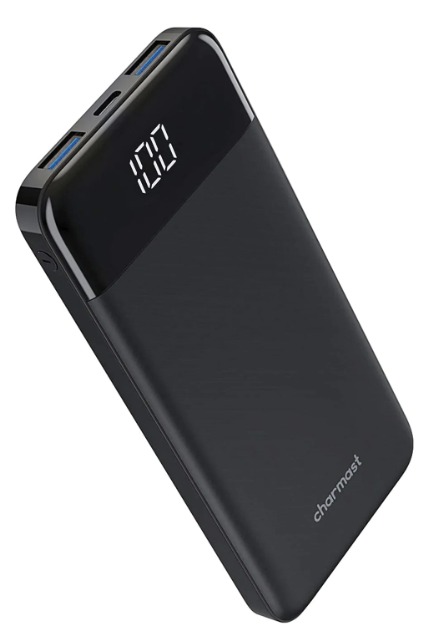
Choose If: You want a display screen which shows remaining battery
I don’t know much about this brand and am hesitant to trust them (though they do have a lot of great reviews). The reason it is worth considering is because it’s one of the few power banks with a digital display. The display is very useful when you are carefully rationing your power supply. It’s also got lots of other nice features like quick charging. I wish it had a USB-A port though.
What About Power Banks with Built-in Solar Panels?
I used to think these were awesome and practical. Then I actually tried one. Guess what? Turns out it is NOT a good idea to leave a power bank out in the blazing hot sun! The model I had worked for a while and then quickly died. I’ve heard the same from other users.
On top of that, most have no power display so there’s no way of knowing the charge level. You can easily over-charge the power bank, meaning it gets fried. But leave it out too little and it won’t have enough power for your needs.
If a reputable brand (instead of cheap Chinese generic brands) started making one of these, I might give it a try. Until then, I’ll keep my power bank and solar panel separate.
Power Bank Capacity and Backpacking
Power bank batteries have capacity measured in Milliamp hours, or mAh. This stands for how much power the battery can provide per hour.
For example, if your device requires 1000 Milliamps per hour, then a 3,000mAh battery will (in theory*) keep it going for 3 hours.
Important: No power bank delivers its full capacity!
Because of efficiency issues, most power banks will only deliver 66-74% of the listed capacity. So, a 10,000mAh power bank may only really give you 6,666mAh. (1, 2)
Some better power banks are more efficient, like the Anker power banks that deliver around 80%-90% of their listed capacity. Take this into consideration when calculating your power needs.
What Capacity Power Bank Do I Need?
The amount of capacity you need for a backpacking trip ultimately depends on which devices you’ll bring and how often you use them. For a week-long backpacking trip, a 10,000mAh power bank is more than adequate for me. This is enough to recharge my headlamp and camera. I mainly use a paper map for navigation though, so don’t need to charge my phone or a GPS.
To figure out how much power you need:
- Tally up the mAh/day amount for each gadget you are bringing.
- Multiply this number by the how many days your backpacking trip will be (or how long until a refuel).
- To play it safe, assume that the power bank will only deliver 66% of its advertised capacity.
- Divide the total mAh you need by 0.66.
Example: If you need 3,000mAh of power to keep your phone charged for a 3-day backpacking trip.
3,000/0.66 = 4,545mAh
Other Things to Look At When Choosing a Backpacking Power Bank
Aside from capacity, you’ll also want to look at the weight of the power bank, you’ll want to look at:
- mAh per ounce
- Charging speed
- Number of outlet ports
- Brand quality
- Other features
mAh per Ounce
It’s pointless to get a lightweight power bank if it won’t meet your power requirements. So, when it comes to weight, you should really look at mAh per ounce. Aim for at least 1,400 mAh per ounce. If you need special features, then you might only get 1,000 mAh per ounce.
Charging Speed
Look at both the input and output speeds of the power bank. Most will be 1A to 3A. Note that, if there are multiple out ports, the speed is usually divided between the ports. So two devices plugged into a 3A power bank would only charge at 1.5A each.
Faster isn’t always better with power banks though. You’ll lose efficiency at higher speeds, meaning your power bank will drain much faster. You probably don’t need to charge anything quickly while backpacking, so a slow outlet speed is fine.
For long thru-hikes, recharge time matters!
If it takes forever to refill your power bank, you will go crazy waiting in town. One backpacker even noted how he had to stay at hotels in order to refill his power bank, so it ended up being expensive too.
Note: How fast a power bank can charge also has a lot to do with the cables. So make sure you invest in some good quality cables and not the cheap Chinese knockoff ones.
Number of Outlet Ports
If you need to charge multiple devices at once, you’ll need more than one outlet. Just note that charging speed typically reduces when you plug in multiple devices.
Brand Quality
I’ve learned my lesson about buying cheap knockoff brands of power banks. While some do work well (at first), they tend to lose their capacity quickly. I had one completely stop charging on me. Luckily it was on a camping trip and not a long backpacking trip.
Extra Features
Some other nice features which are worth paying extra for or even worth the extra weight are:
- Digital displays or power level indicators (LOVE this feature)
- Waterproof
- Durable casing (will add extra weight though)
- Wireless charging
What About Solar Panels?
If you have very high power needs (such as if you are doing a lot of photography), even a 25,000mAH power bank probably won’t cut it. You’ll want a portable solar panel to keep charged.
Bear in mind that solar panels are often hyped up. They are cool, but require very sunny conditions to work well. They can also be heavy, bulky, and annoying to worry about. But, there are plenty of reliable solar panels which range from ultralight 5 watt solutions to higher wattages. See these best ultralight solar panels for backpacking.


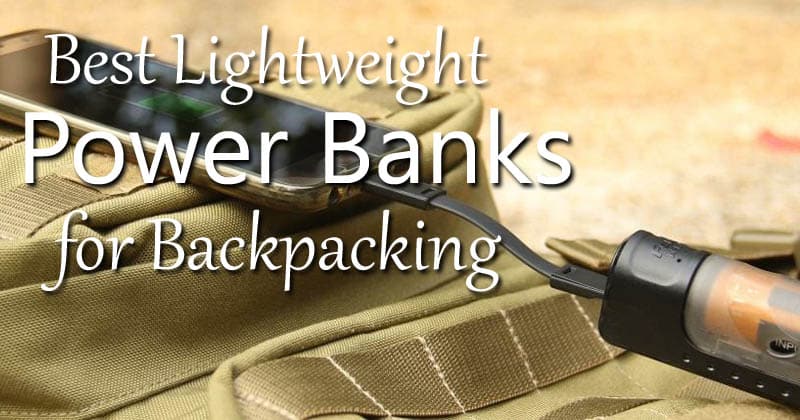
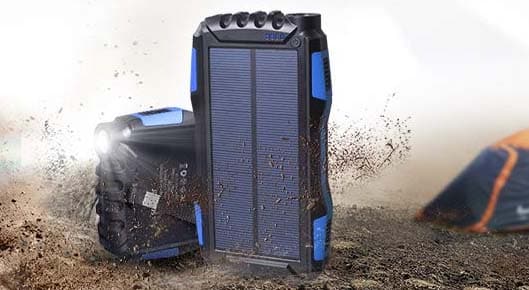

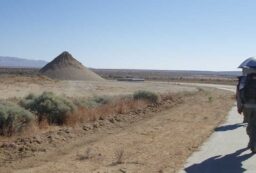








Post your comments